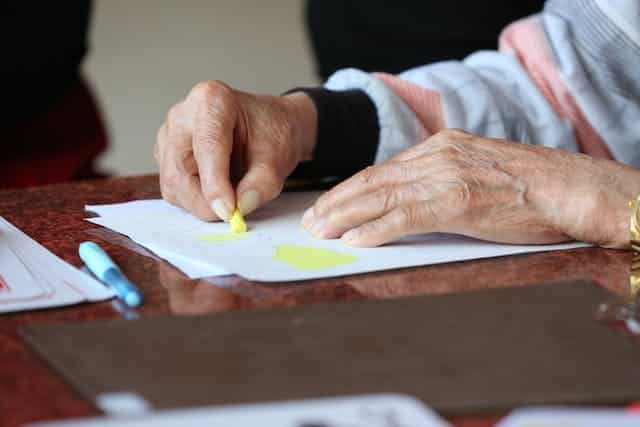Approximately 3.6 million Australians are affected by arthritis – that’s about 15% of the population. Though it can’t be cured, getting the right arthritis treatment can considerably improve your quality of life. Whether you’re newly diagnosed or have a family member with this condition, our article is here to help.
We’ve rounded up your most asked questions about arthritis and we’ve answered them, including how it starts, what it feels like, and how to treat it.
In this article

What is arthritis?
Arthritis is a common condition that causes inflammation and pain in one or more joints. It’s characterised by stiffness, swelling, and decreased range of motion, which typically worsens with age.
Types of arthritis
Arthritis is a term that encompasses more than 100 conditions that affect the joints, with osteoarthritis and rheumatoid arthritis being the most common.
Osteoarthritis
This type occurs when the cartilage that cushions the ends of bones in your joints gradually deteriorates. The wear and tear can lead to pain, swelling, and reduced motion.
Osteoarthritis can affect any joint but commonly affects the hands, knees, hips, and spine. Risk factors include aging, joint injury, obesity, and genetics.
Rheumatoid arthritis
Rheumatoid arthritis is an autoimmune condition where the body’s immune system mistakenly attacks the joints. This leads to inflammation that can cause joint damage and pain.
Unlike osteoarthritis, which affects the cartilage, rheumatoid arthritis affects the lining of the joints, causing painful swelling. It can sometimes cause physical deformities and can also impact other parts of the body. It’s more common in women than in men.
We talk more about autoimmune arthritis in our piece on World Autoimmune Arthritis Day.
Psoriatic arthritis
Psoriatic arthritis affects some people who have psoriasis, a condition that features red patches of skin topped with silvery scales. Most people develop psoriasis first and are later diagnosed with psoriatic arthritis.
It can affect any part of the body, including fingertips and spine, and can range from relatively mild to severe.
Gout
Gout is a form of arthritis characterised by sudden, severe attacks of pain, swelling, redness, and tenderness in the joints, often the joint at the base of the big toe. It’s caused by urate crystals accumulating in the joint, due to high levels of uric acid in the blood.
Gout attacks can come suddenly and are often very painful.
Juvenile arthritis
Juvenile arthritis is the term used to describe arthritis when it begins before the age of 16.
It can cause joint swelling, pain, and stiffness that may last for a few weeks or may be permanent. Types of juvenile arthritis include juvenile rheumatoid arthritis, juvenile chronic arthritis, and juvenile idiopathic arthritis.
Ankylosing spondylitis
This type of arthritis primarily affects the spine, although other joints can become involved. It causes inflammation of the spinal joints that can lead to severe, chronic pain and discomfort.
In the most advanced cases, this inflammation can lead to new bone formation on the spine, causing the spine to fuse in a fixed, immobile position.

Can arthritis be cured?
Unfortunately, arthritis cannot be fully cured. However, several treatments exist to manage its symptoms. These include medications to reduce pain and inflammation, physical therapies to maintain joint mobility, and lifestyle changes like regular exercise and a healthy diet. In severe cases, surgery might be needed.
It’s important for those with arthritis to work closely with healthcare professionals for the best care plan. Regular check-ups and tailored treatments can significantly help in managing the condition effectively.
What does arthritis pain feel like?
Arthritis pain can be aching or sharp and your joints might swell and feel tender. It can be hard to move the affected area, which can make daily tasks difficult. The symptoms can vary, and they often come and go. Cold weather and activity can make it worse. Sometimes, the joints might feel warm or look red.
When does arthritis start?
This condition can start at any age, but it’s more common in older people. Some types, like juvenile arthritis, begin in childhood. Others, like osteoarthritis, often start in middle age or later.
The emergence of this uncomfortable condition depends on several factors including the type of arthritis, genetics, and lifestyle.

Arthritis treatment
There are a number of treatments available for managing the symptoms of arthritis. Here are the common ones:
Medication
You can take medicine to ease pain and swelling. Doctors often prescribe painkillers like paracetamol or anti-inflammatory drugs but may suggest stronger medicines for severe pain.
Physiotherapy
Physiotherapy helps keep your joints moving. A physiotherapist will show you special exercises to strengthen muscles around your joints and improve flexibility.
Healthy lifestyle
Eating healthy and staying at a good weight is important as it reduces stress on your joints. Regular, gentle exercise, like walking or swimming, also helps.
Heat and cold treatments
Using heat, like a warm bath, or cold, like an ice pack, can ease pain. Heat relaxes your muscles and improves circulation. Cold helps reduce swelling and numbs deep pain.
Surgery
In severe cases, you might need surgery. This can replace or repair damaged joints. Surgery usually helps reduce pain and improve movement.
Alternative therapies
Some people try acupuncture or massages to help with pain relief. Always talk to your doctor before trying alternative therapies.

Where does arthritis come from?
Arthritis is caused by a combination of factors that may vary depending on the specific type. The causes can be broadly categorised into several main groups, including wear and tear, autoimmune responses, infections, and more.
Here’s a breakdown of the primary causes associated with different types:
1. Wear and tear (Osteoarthritis)
- Mechanical stress: Repeated stress on a joint, due to activities or occupations that involve repetitive movement, can lead to osteoarthritis.
- Aging: The risk of developing osteoarthritis increases with age as the cartilage in joints gradually wears down over time.
- Obesity: Excess weight increases stress on weight-bearing joints, like the knees and hips, which can lead to osteoarthritis.
- Injury: Past injuries to joints, such as fractures or ligament tears, can increase the risk of osteoarthritis.
2. Autoimmune disorders (Rheumatoid Arthritis, Psoriatic Arthritis, Lupus)
- Genetic factors: Certain genes can make individuals more susceptible to autoimmune conditions where the body’s immune system mistakenly attacks its own tissues.
- Environmental triggers: Infections, smoking, and exposure to certain chemicals may trigger autoimmune responses in genetically susceptible individuals.
3. Metabolic Abnormalities (Gout)
- High uric acid levels: Gout is caused by the accumulation of urate crystals in the joint, resulting from high levels of uric acid in the blood. This can be due to diet, genetic predisposition, or underexcretion of urate.
4. Infections (Infectious Arthritis)
- Bacterial, viral, or fungal infections: Microorganisms can infect a joint directly or through the bloodstream, causing inflammation and symptoms of arthritis.
5. Other causes
- Genetic factors: Some types, such as certain forms of juvenile idiopathic arthritis, have a genetic component that makes them more likely to occur in families.
- Physical activity and diet: Lifestyle factors, including physical activity and diet, can influence the risk of developing certain types of arthritis.

Advances in arthritis treatment
Doctors are helping people with arthritis with cutting-edge medicines, improved surgeries, and new therapies. These advances are making a big difference in reducing pain and improving people’s lives.
Biologic medications
This is a newer type of treatment for some forms of arthritis, like rheumatoid arthritis. They work by targeting specific parts of the immune system that trigger inflammation and joint damage. These drugs are often given by injection and can be very effective in reducing symptoms and slowing disease progression.
Joint replacement surgery
Advances in joint replacement surgery, especially for knees and hips, have improved outcomes for people with severe arthritis. New techniques and materials mean these surgeries are more successful and last longer. They can greatly reduce pain and improve mobility for people with severe joint damage.
Physical therapy techniques
Therapists use exercises and treatments tailored to each person’s needs to help people with arthritis stay active and mobile. This helps to strengthen muscles around the joints, maintain joint flexibility, and reduce pain.
Pain management advances
Advances in pain management, including new types of medication and non-drug therapies, help people manage their pain better. These include topical treatments, nerve stimulation therapies, and new types of anti-inflammatory drugs that have fewer side effects.
Stem cell therapy
This emerging treatment involves using the body’s own cells to repair damaged tissues. While still in the early stages, it shows promise for helping to repair damaged joint tissue and reduce pain.
Insurance for your independence
If arthritis means you or your family member relies on a wheelchair or mobility scooter, you know how important this equipment is to your independence.
Going through regular insurance providers can be daunting and expensive, and even then you might not source appropriate cover for your needs as someone living with disability. Blue Badge Insurance is Australia’s first disability and independence insurance specialist. We understand the needs of people who live with disability and pride ourselves in providing tailored, suitable cover.
Find out more about our wheelchair insurance and mobility scooter insurance. Your disability parking permit also gets you Blue Badge insurance discounts across insurance for wheelchair accessible vehicles, pet insurance and more.








